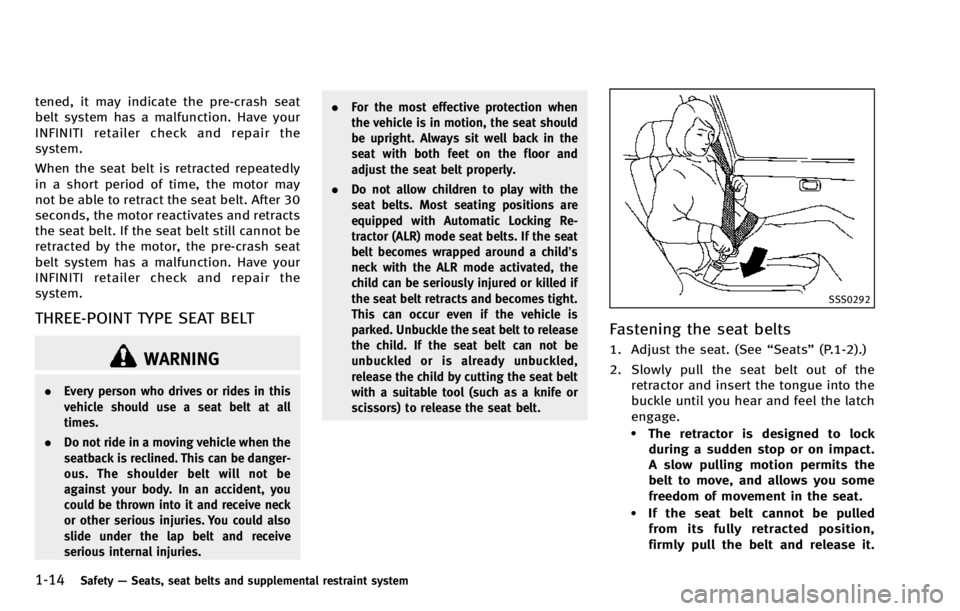lock INFINITI QX70 2014 Owners Manual
[x] Cancel search | Manufacturer: INFINITI, Model Year: 2014, Model line: QX70, Model: INFINITI QX70 2014Pages: 530, PDF Size: 2.48 MB
Page 10 of 530

JVC0317X
1. Hood (P.3-18)
2. Headlight and turn signal (P.2-38)—Bulb replacement (P.8-29)
— Adaptive Front lighting System
(AFS) (if so equipped) (P.2-42)
3. Windshield wiper and washer (P.2-34) —
Maintenance (P.8-22)
4. Moonroof (P.2-62)
5. Roof rack (if so equipped) (P.2-59)
6. Power windows (P.2-60)
7. Outside mirrors (P.3-30) —
Side view camera (if so equipped)
(P.4-31)
— Welcome light (P.2-64)
8. Doors —Keys (P.3-2)
— Door locks (P.3-4)
— Intelligent Key system (P.3-6)
— Remote keyless entry system
(P.3-14)
9. Recovery hook (P.6-16)
10. Front view camera (if so equipped) (P.4-31)
11. Fog light (P.2-44)
12. Sonar sensor (if so equipped) —Around View Monitor (P.4-31)
13. Tires —Wheel and tires (P.8-32, P.9-9)
— Flat tire (P.6-3)
— Tire pressure monitoring system
(TPMS) (P.2-16, P.5-4)
Illustrated table of contents0-3
EXTERIOR FRONT
Page 11 of 530

0-4Illustrated table of contents
SSI0446
1. Rear view camera (P.4-24, P.4-31)
2. Lift gate (P.3-18)—Intelligent Key system (P.3-6)
— Remote keyless entry system
(P.3-14)
3. Rear window defroster (P.2-37) 4. High-mounted stop light (Bulb repla-
cement) (P.8-29)
5. Rear window wiper and washer (P.2-37)
—Maintenance (P.8-24)
6. Antenna (P.4-91) 7. Sonar sensor (if so equipped)
—Around View Monitor (P.4-31)
8. Rear combination light (Bulb replace- ment) (P.8-29)
9. Fuel-filler door (P.3-24) —Fuel recommendation (P.9-4)
10. Child safety rear door locks (P.3-6)
EXTERIOR REAR
Page 15 of 530

0-8Illustrated table of contents
JVC0209X
1. Side ventilator (P.4-48)
2. Paddle shifter (if so equipped) (P.5-17)
3. Meters and gauges (P.2-6)
4. Center ventilator (P.4-48)
5. Center multi-function control panel—Navigation system* (if so equipped)
—
Vehicle information and setting
buttons (P.4-9)
— Around View Monitor (if so
equipped) (P.4-31)
6. Center display (P.4-3) 7. Clock (P.2-50)
8. Hazard warning flasher switch (P.6-2)
9. Front passenger supplemental air bag
(P.1-37)
10. Hood release handle (P.3-18)
11. Fuse box cover (P.8-25)
12. Parking brake (P.5-20)
13. Steering wheel —Horn (P.2-44)
— Driver supplement air bag (P.1-37)
14. Push-button ignition switch (P.5-11)
15. Front passenger air bag status light (P.1-42)
16. Rear window defroster switch (P.2-37)
17. Power outlet (P.2-50)
18. Automatic climate control system (P.4-48)
19. Audio system (P.4-54)
20. Glove box lid release handle (P.2-53)
*: Refer to the separate Navigation System
Owner’s Manual.
INSTRUMENT PANEL
Page 19 of 530

0-12Illustrated table of contents
Warninglight Name
Page
All-Wheel Drive (AWD) warning
light (AWD models)* 2-14
Anti-lock Braking System (ABS)
warning light2-14
Automatic Transmission check
warning light
2-14
Brake warning light
2-14
Charge warning light2-15
Distance Control Assist (DCA)
system warning light (orange)* 2-15
Engine oil pressure warning
light
2-15
Intelligent Cruise Control (ICC)
system warning light (orange)*2-16
Intelligent Key warning light 2-16
Lane departure warning light
(orange)*
2-16
Low tire pressure warning light 2-16
Master warning light
2-18
Preview Function warning light
(orange)* 2-18
Rear Active Steer warning light* 2-18 Warning
light Name Page
Seat belt warning light 2-18
Supplemental air bag warning
light 2-18
Vehicle Dynamic Control (VDC)
warning light2-19Indicator
light Name
Page
Adaptive Front lighting System
(AFS) indicator light* 2-19
Automatic Transmission posi-
tion indicator light
2-19
Exterior light indicator
2-20
Front passenger air bag status
light 2-20
High beam indicator light 2-20
Intelligent Brake Assist (IBA) off
indicator light*2-20
Lane Departure Prevention
(LDP) ON indicator light (green)*2-20
Malfunction Indicator Light
(MIL)2-20
Security indicator light 2-21
SPORT mode indicator light* 2-21
Turn signal/hazard indicator
lights
2-21
Vehicle Dynamic Control (VDC)
off indicator light2-21
*: if so equipped
WARNING AND INDICATOR LIGHTS
Page 23 of 530

1-2Safety—Seats, seat belts and supplemental restraint system
SSS0133
WARNING
. Do not ride in a moving vehicle when the
seatback is reclined. This can be danger-
ous. The shoulder belt will not be
against your body. In an accident, you
could be thrown into it and receive neck
or other serious injuries. You could also
slide under the lap belt and receive
serious internal injuries.
. For the most effective protection when
the vehicle is in motion, the seat should
be upright. Always sit well back in the seat with both feet on the floor and
adjust the seat belt properly. See
“Pre-
cautions on seat belt usage” (P.1-11).
. After adjustment, gently rock in the seat
to make sure it is securely locked.
. Do not leave children unattended inside
the vehicle. They could unknowingly
activate switches or controls. Unat-
tended children could become involved
in serious accidents.
. The seatback should not be reclined any
more than needed for comfort. Seat belts
are most effective when the passenger sits well back and straight up in the
seat. If the seatback is reclined, the risk
of sliding under the lap belt and being
injured is increased.
SEATS
Page 27 of 530

1-6Safety—Seats, seat belts and supplemental restraint system
WARNING
. Do not ride in a moving vehicle when the
seatback is reclined. This can be danger-
ous. The shoulder belt will not be
against your body. In an accident, you
could be thrown into it and receive neck
or other serious injuries. You could also
slide under the lap belt and receive
serious internal injuries.
. For the most effective protection when
the vehicle is in motion, the seat should
be upright. Always sit well back in the
seat with both feet on the floor and
adjust the seat belt properly. See “Pre-
cautions on seat belt usage” (P.1-11).
. After adjustment, check to be sure the
seat is securely locked.
SSS0895
Folding
Before folding the rear seats:
Remove drink containers from the rear cup
holder.
To fold down the seatbacks:
Pull the lever
*Aor*Band fold the
seatback.
Return the rear seatback manually until it
securely locks in position.
HEAD RESTRAINTS
WARNING
Head restraints supplement the other vehi-
cle safety systems. They may provide addi-
tional protection against injury in certain
rear end collisions. Adjust the head re-
straints properly, as specified in this sec-
tion. Check the adjustment after someone
else uses the seat. Do not attach anything
to the head restraint stalks or remove the
head restraint. Do not use the seat if the
head restraint has been removed. If the
head restraint was removed, reinstall and
properly adjust the head restraint before an
occupant uses the seating position. Failure
to follow these instructions can reduce the
effectiveness of the head restraints. This
may increase the risk of serious injury or
death in a collision.
Page 28 of 530

JVR0051X
The illustration shows the seating posi-
tions equipped with head restraints and
headrest. The head restraints are adjusta-
ble.
Indicates the seating position is
equipped with a head restraint.
+ indicates the seating position is
equipped with a headrest.
SSS0992
Components
1. Head restraint
2. Adjustment notches
3. Lock knob
4. Stalks
SSS0997
Adjustment
Adjust the head restraint so the center is
level with the center of your ears.
Safety —Seats, seat belts and supplemental restraint system1-7
Page 29 of 530

1-8Safety—Seats, seat belts and supplemental restraint system
SSS0993
To raise the head restraint, pull it up.
SSS0994
To lower, push and hold the lock knob and
push the head restraint down.
SSS0995
Removal
Use the following procedure to remove the
adjustable head restraints.
1. Pull the head restraint up to the highest
position.
2. Push and hold the lock knob.
3. Remove the head restraint from the seat.
4. Store the head restraint properly in a secure place so it is not loose in the
vehicle.
5. Reinstall and properly adjust the head restraint before an occupant uses the
Page 30 of 530

seating position.
SSS0996
Install
1. Align the head restraint stalks with theholes in the seat. Make sure that the
head restraint is facing the correct
direction. The stalk with the adjustment
notches
*1must be installed in the
hole with the lock knob
*2.
2. Push and hold the lock knob and push the head restraint down.
3. Properly adjust the head restraint before an occupant uses the seating
position.
SSS0508
Front-seat Active Head Restraint
The Active Head Restraint moves forward
utilizing the force that the seatback re-
ceives from the occupant in a rear-end
collision. The movement of the head
restraint helps support the occupant’ s
head by reducing its backward movement
and helping absorb some of the forces that
may lead to whiplash-type injuries.
Active Head Restraints are effective for
collisions at low to medium speeds in
which it is said that whiplash injury occurs
most.
Active Head Restraints operate only in
Safety —Seats, seat belts and supplemental restraint system1-9
Page 35 of 530

1-14Safety—Seats, seat belts and supplemental restraint system
tened, it may indicate the pre-crash seat
belt system has a malfunction. Have your
INFINITI retailer check and repair the
system.
When the seat belt is retracted repeatedly
in a short period of time, the motor may
not be able to retract the seat belt. After 30
seconds, the motor reactivates and retracts
the seat belt. If the seat belt still cannot be
retracted by the motor, the pre-crash seat
belt system has a malfunction. Have your
INFINITI retailer check and repair the
system.
THREE-POINT TYPE SEAT BELT
WARNING
. Every person who drives or rides in this
vehicle should use a seat belt at all
times.
. Do not ride in a moving vehicle when the
seatback is reclined. This can be danger-
ous. The shoulder belt will not be
against your body. In an accident, you
could be thrown into it and receive neck
or other serious injuries. You could also
slide under the lap belt and receive
serious internal injuries. .
For the most effective protection when
the vehicle is in motion, the seat should
be upright. Always sit well back in the
seat with both feet on the floor and
adjust the seat belt properly.
. Do not allow children to play with the
seat belts. Most seating positions are
equipped with Automatic Locking Re-
tractor (ALR) mode seat belts. If the seat
belt becomes wrapped around a child’s
neck with the ALR mode activated, the
child can be seriously injured or killed if
the seat belt retracts and becomes tight.
This can occur even if the vehicle is
parked. Unbuckle the seat belt to release
the child. If the seat belt can not be
unbuckled or is already unbuckled,
release the child by cutting the seat belt
with a suitable tool (such as a knife or
scissors) to release the seat belt.
SSS0292
Fastening the seat belts
1. Adjust the seat. (See “Seats”(P.1-2).)
2. Slowly pull the seat belt out of the retractor and insert the tongue into the
buckle until you hear and feel the latch
engage.
.The retractor is designed to lockduring a sudden stop or on impact.
A slow pulling motion permits the
belt to move, and allows you some
freedom of movement in the seat.
.If the seat belt cannot be pulledfrom its fully retracted position,
firmly pull the belt and release it.